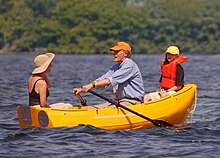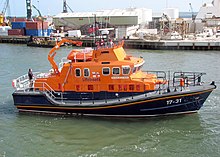

A watercraft or waterborne vessel is any vehicle designed for travel across or through water bodies, such as a boat, ship, hovercraft, submersible or submarine.


A watercraft or waterborne vessel is any vehicle designed for travel across or through water bodies, such as a boat, ship, hovercraft, submersible or submarine.
Watercraft can be grouped into surface vessels, which include ships, yachts, boats, hydroplanes, wingships, unmanned surface vehicles, sailboards and human-powered craft such as rafts, canoes, kayaks and paddleboards;[2] underwater vessels, which include submarines, submersibles, unmanned underwater vehicles (UUVs), wet subs and diver propulsion vehicles; and amphibious vehicles, which include hovercraft, car boats, amphibious ATVs and seaplanes. Many of these watercraft have a variety of subcategories and are used for different needs and applications.
|
Main article: Naval architecture |
The design of watercraft requires a tradeoff among internal capacity (tonnage), speed and seaworthiness. Tonnage is important for transport of goods, speed is important for warships and racing vessels, and the degree of seaworthiness varies according to the bodies of water on which a watercraft is used. Regulations apply to larger watercraft, to avoid foundering at sea and other problems. Design technologies include the use of computer modeling and ship model basin testing before construction.[3]

Watercraft propulsion can be divided into five categories.
Any one watercraft might use more than one of these methods at different times or in conjunction with each other. For instance, early steamships often set sails to work alongside the engine power. Before steam tugs became common, sailing vessels would back and fill their sails to maintain a good position in a tidal stream while drifting with the tide in or out of a river. In a modern yacht, motor-sailing – travelling under the power of both sails and engine – is a common method of making progress, if only in and out of harbour.[4]: 33–34 [5]: 199–202 [6]